Hip
Hip Care That Gets You Moving Again
Hip pain can quickly impact your ability to do the simple things you love. When movement causes pain, Jacksonville residents turn to Dr. Rizk for a solution to eliminate hip pain and discomfort and provide you with the ability to move again. From arthritis to total hip replacement Dr. Rizk will conduct a complete review of your case and create a customized treatment plan. For Hip Replacement, click here.
Hip Ailments & Treatment Options
The most common types of arthritis are osteoarthritis and rheumatoid arthritis, but there are actually more than 100 different types of inflammatory arthritis. According to the NIH, in 2012, more than 51 million people suffered from some form of arthritis.
Anatomy of the Hip
The hip is a “ball-and-socket” joint. The socket is formed by the acetabulum, which is part of the large pelvis bone. The ball is the femoral head, which is the upper end of the femur (thighbone).
The bone surfaces of the ball and socket are covered with articular cartilage, a smooth, slippery substance that protects and cushions the bones and enables them to move easily.
The surface of the joint is covered by a thin lining called the synovium. In a healthy hip, the synovium produces a small amount of fluid that lubricates the cartilage and aids in movement.
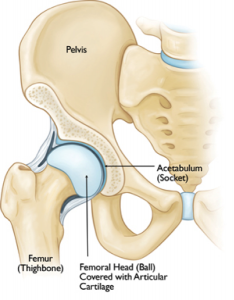
Hip Pain Causes & Treatment Explained by Dr. Rizk
Types of Hip Arthritis
Rheumatoid Arthritis
Rheumatoid arthritis is a systemic disorder, that is; it affects your entire body and not just the hip joint. The inflammation is related to an immune system response rather than wear and tear. The hip joint, like other joints in the body, is protected by a special capsule that completely surrounds the joint. This capsule has a special lining (the synovial lining) and is filled with lubricant (joint fluid) that helps the joint move smoothly.
Rheumatoid arthritis typically causes a swelling of the synovial lining. This causes pain and swelling. Eventually, rheumatoid arthritis can cause the bone and cartilage of the joint itself to deteriorate. Rheumatoid arthritis can occur in people of all ages, including children (where it is known as juvenile rheumatoid arthritis), and is more common in women than men. Unlike osteoarthritis of the hip, which may occur only in one hip, rheumatoid arthritis typically occurs in both hips at the same time (and possibly other joints.) Rheumatoid arthritis is also associated with overall weakness and fatigue. Medications to treat rheumatoid arthritis continue to improve.
Ankylosing Spondylitis
Ankylosing spondylitis is a chronic inflammation of the spine and sacroiliac joint (the joint where the spine meets the pelvis) which can sometimes cause inflammation of the hip joint. Ankylosing spondylitis can occur in people of all ages, including children, and typically begins in a person between the ages of 17 and 35. It is more common in men than women. It is typical for people with ankylosing spondylitis to experience flare-ups when the condition is worse, followed by periods of remission with mild to no symptoms.
Systemic Lupus Erythematosus
Systemic lupus erythematosus or lupus is a systemic autoimmune disorder that can affect any part of the body, including the hip joint. If lupus strikes the hip, inflammation and damage to the joint can occur. Lupus can occur in people of all ages but it is most common in women aged 15 to 35.
Psoriatic Arthritis
As the name sounds, this type of arthritis is related to the skin condition psoriasis. Psoriatic arthritis causes joint pain, swelling, and stiffness and can affect any joint in the body, including the hip. Most people with psoriatic arthritis have the skin condition first (scaly red patches of skin) but it is possible to develop psoriatic arthritis before the skin condition occurs.
Osteoarthritis
Osteoarthritis is a degenerative type of arthritis that occurs most often in people 50 years of age and older, though it may occur in younger people, too. In osteoarthritis, the cartilage in the hip joint gradually wears away over time.
As the cartilage wears away, it becomes frayed and rough, and the protective joint space between the bones decreases. This can result in bone rubbing on bone. To make up for the lost cartilage, the damaged bones may start to grow outward and form bone spurs (osteophytes). Osteoarthritis develops slowly and the pain it causes worsens over time.
Types of Hip Arthritis
Rheumatoid Arthritis
Rheumatoid arthritis is a systemic disorder, that is; it affects your entire body and not just the hip joint. The inflammation is related to an immune system response rather than wear and tear. The hip joint, like other joints in the body, is protected by a special capsule that completely surrounds the joint. This capsule has a special lining (the synovial lining) and is filled with lubricant (joint fluid) that helps the joint move smoothly.
Rheumatoid arthritis typically causes a swelling of the synovial lining. This causes pain and swelling. Eventually, rheumatoid arthritis can cause the bone and cartilage of the joint itself to deteriorate. Rheumatoid arthritis can occur in people of all ages, including children (where it is known as juvenile rheumatoid arthritis), and is more common in women than men. Unlike osteoarthritis of the hip, which may occur only in one hip, rheumatoid arthritis typically occurs in both hips at the same time (and possibly other joints.) Rheumatoid arthritis is also associated with overall weakness and fatigue. Medications to treat rheumatoid arthritis continue to improve.
Ankylosing Spondylitis
Ankylosing spondylitis is a chronic inflammation of the spine and sacroiliac joint (the joint where the spine meets the pelvis) which can sometimes cause inflammation of the hip joint. Ankylosing spondylitis can occur in people of all ages, including children, and typically begins in a person between the ages of 17 and 35. It is more common in men than women. It is typical for people with ankylosing spondylitis to experience flare-ups when the condition is worse, followed by periods of remission with mild to no symptoms.
Systemic Lupus Erythematosus
Systemic lupus erythematosus or lupus is a systemic autoimmune disorder that can affect any part of the body, including the hip joint. If lupus strikes the hip, inflammation and damage to the joint can occur. Lupus can occur in people of all ages but it is most common in women aged 15 to 35.
Psoriatic Arthritis
As the name sounds, this type of arthritis is related to the skin condition psoriasis. Psoriatic arthritis causes joint pain, swelling, and stiffness and can affect any joint in the body, including the hip. Most people with psoriatic arthritis have the skin condition first (scaly red patches of skin) but it is possible to develop psoriatic arthritis before the skin condition occurs.
Osteoarthritis
Osteoarthritis is a degenerative type of arthritis that occurs most often in people 50 years of age and older, though it may occur in younger people, too. In osteoarthritis, the cartilage in the hip joint gradually wears away over time.
As the cartilage wears away, it becomes frayed and rough, and the protective joint space between the bones decreases. This can result in bone rubbing on bone. To make up for the lost cartilage, the damaged bones may start to grow outward and form bone spurs (osteophytes). Osteoarthritis develops slowly and the pain it causes worsens over time.
Causes of Hip Arthritis
Osteoarthritis has no single specific cause, but there are certain factors that may make you more likely to develop the disease, including:
- Increasing age
- Family history of osteoarthritis
- Previous injury to the hip joint
- Obesity
- Improper formation of the hip joint at birth, a condition known as developmental dysplasia of the hip
Even if you do not have any of the risk factors listed above, you can still develop osteoarthritis.
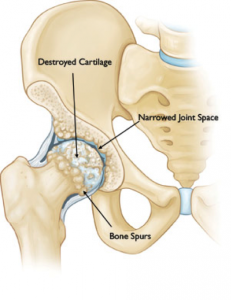
Symptoms
The most common symptom of hip osteoarthritis is pain around the hip joint. Usually, the pain develops slowly and worsens over time, although sudden onset is also possible. Pain and stiffness may be worse in the morning, or after sitting or resting for a while. Over time, painful symptoms may occur more frequently, including during rest or at night. Additional symptoms may include:
- Pain in your groin or thigh that radiates to your buttocks or your knee
- Pain that flares up with vigorous activity
- Stiffness in the hip joint that makes it difficult to walk or bend
- “Locking” or “sticking” of the joint, and a grinding noise (crepitus) during movement caused by loose fragments of cartilage and other tissue interfering with the smooth motion of the hip
- Decreased range of motion in the hip that affects the ability to walk and may cause a limp
- Increased joint pain with rainy weather
Doctor Examination
During your appointment, Dr. Rizk will talk with you about your symptoms and medical history, conduct a physical examination, and possibly order diagnostic tests, such as x-rays.
Physical Examination
During the physical examination, Dr. Rizk will look for:
- Tenderness about the hip
- Range of passive (assisted) and active (self-directed) motion
- Crepitus (a grating sensation inside the joint) with movement
- Pain when pressure is placed on the hip
- Problems with your gait (the way you walk)
- Any signs of injury to the muscles, tendons, and ligaments surrounding the hip
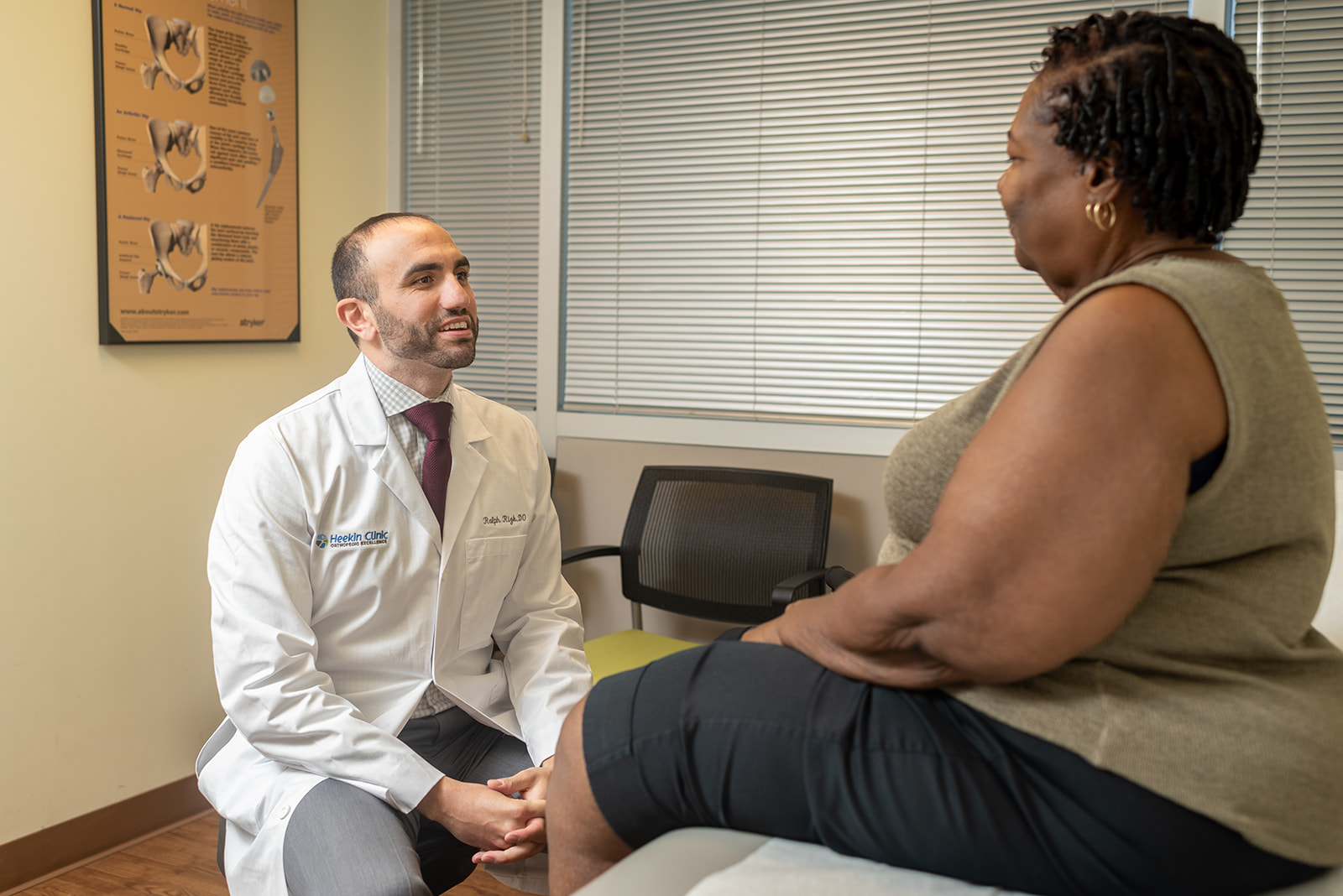
Imaging Tests
X-rays: These imaging tests create detailed pictures of dense structures, like bones. X-rays of an arthritic hip may show a narrowing of the joint space, changes in the bone, and the formation of bone spurs (osteophytes).
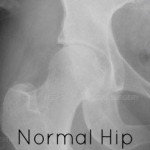
In the x-ray of a normal hip (left), the space between the ball and socket indicates healthy cartilage. An x-ray of an arthritic hip (right) shows severe loss of joint space and bone spurs.
Other imaging tests. Occasionally, a magnetic resonance imaging (MRI) scan, a computed tomography (CT) scan, or a bone scan may be needed to better determine the condition of the bone and soft tissues of your hip.

Orthopaedic Hip Treatment Options
Although there is no cure for osteoarthritis, there are a number of treatment options that will help relieve pain and improve mobility.
Click below to learn more about the specified treatment methods.
NONSURGICAL TREATMENT
As with other arthritic conditions, early treatment of osteoarthritis of the hip is nonsurgical. Dr. Rizk may recommend a range of treatment options.
Lifestyle Modifications:
Some changes in your daily life can protect your hip joint and slow the progress of osteoarthritis.
- Minimizing activities that aggravate the condition and switching from high-impact activities (such as jogging or tennis) to lower impact activities (such as swimming or cycling)
- If needed, losing weight can reduce stress on the joint, resulting in less pain and increased function.
Physical Therapy:
Specific exercises can help increase range of motion and flexibility, as well as strengthen the muscles in your hip and leg. Dr. Heekin or a physical therapist can help develop an individualized exercise program that meets your needs and lifestyle.
Assistive Devices:
Using walking supports such as a cane, crutches or a walker can improve mobility and independence. Using assistive aids such as a long-handled reacher to pick up low-lying objects will help you avoid movements that may cause pain.
Medications:
If your pain affects your daily routine or is not relieved by other nonsurgical methods, Dr. Heekin may add medication to your treatment plan.
- Acetaminophen is an over-the-counter pain reliever that can be effective in reducing mild arthritis pain. Like all medications, however, over-the-counter pain relievers can cause side effects and interact with other medications you are taking. Be sure to discuss potential side effects with Dr. Heekin.
- Nonsteroidal anti-inflammatory drugs (NSAIDs) may relieve pain and reduce inflammation. Over-the-counter NSAIDs include naproxen and ibuprofen. Other NSAIDs are available by prescription.
- Corticosteroids (also known as cortisone) are powerful anti-inflammatory agents that can be taken by mouth or injected into the painful joint.
SURGICAL TREATMENT
Dr. Rizk may recommend surgery if your pain from arthritis causes disability and is not relieved with nonsurgical treatment.
Total Hip Replacement:
Dr. Rizk will remove both the damaged acetabulum and femoral head, and then position new metal, plastic or ceramic joint surfaces to restore the function of your hip.
In total hip replacement, both the head of the femur and the socket are replaced with an artificial device.
Complications:
Although complications are possible with any surgery, Dr. Rizk will take steps to minimize the risks. The most common complications of surgery include:
- Infection
- Excessive bleeding
- Blood clots
- Hip dislocation
- Limb length inequality
- Damage to blood vessels or arteries
Dr. Rizk will discuss possible complications with you before your surgery.
Recovery
After any type of surgery for osteoarthritis of the hip, there is a period of recovery. Recovery time and rehabilitation depend on the type of surgery performed.
Dr. Rizk may recommend physical therapy to help you regain strength in your hip and to restore range of motion. After your procedure, you may need to use a cane, crutches or a walker for a period of time.
In most cases, surgery relieves the pain of osteoarthritis and makes it possible to perform daily activities more easily.
Meet Our Doctor
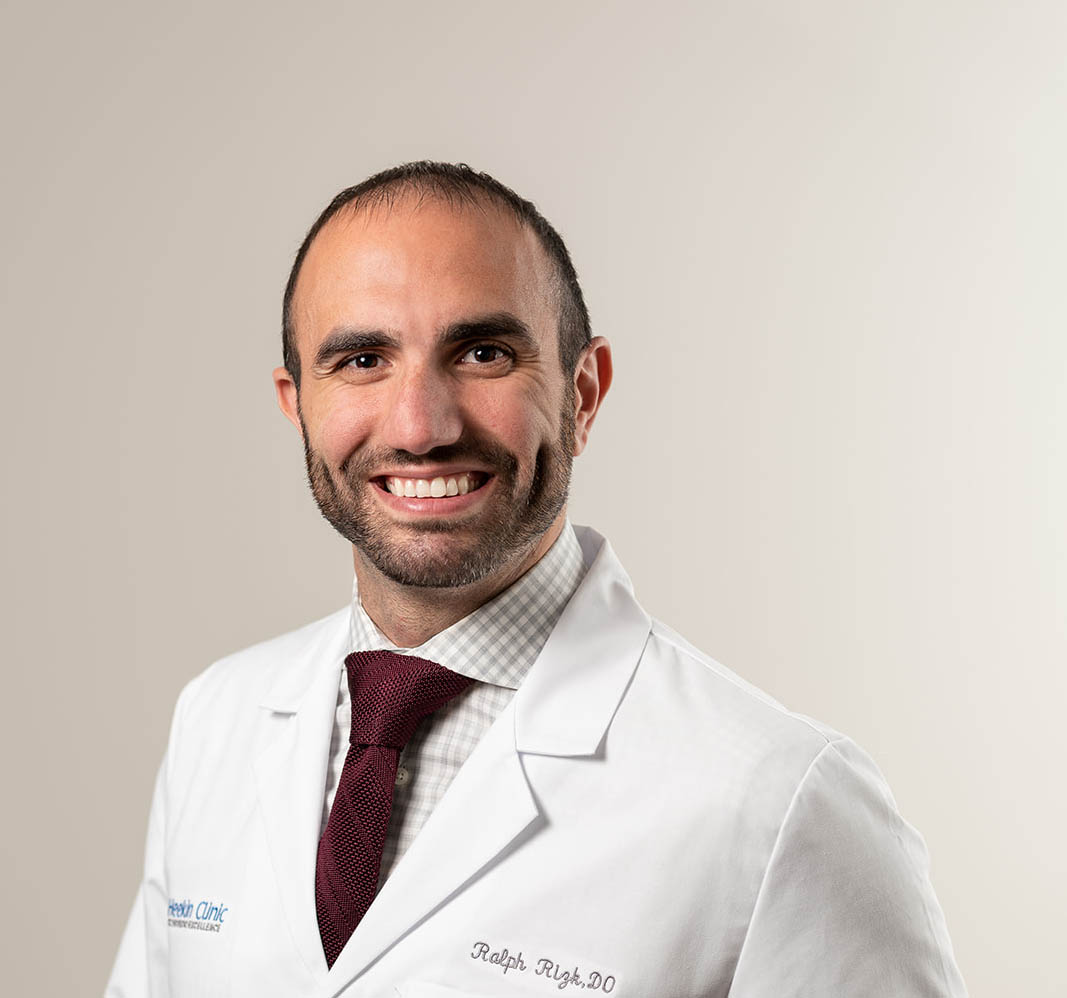
RALPH RIZK, DO
Orthopaedic Surgeon
Dr. Ralph Rizk is an Orthopaedic Surgeon who treats both adults and adolescent patients. He practices surgical Orthopaedics, specializing in Adult Hip and Knee Reconstruction Surgery […]
Wanda H.
PATIENT OF DR. RALPH RIZK
Better Health Care is Our Mission
Flexible scheduling and same-day appointments available!
